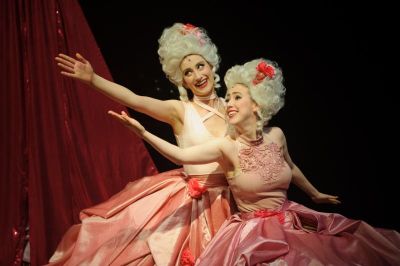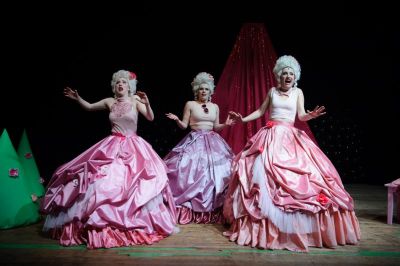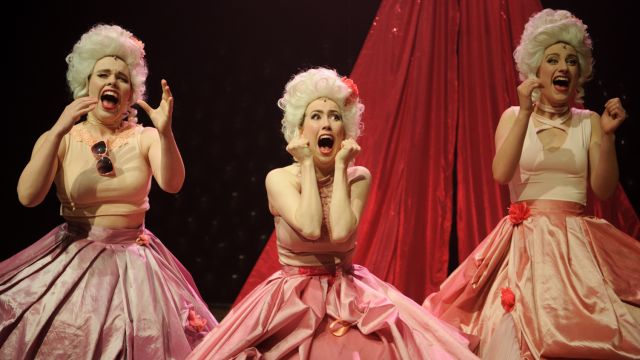LadyCake
They are the gracefully gliding, giggling, girlish devoted handmaidens to Princess-then-Queen Marie Antoinette – she who famously said (or did she?) ‘Let them eat cake.’ Marie Antoinette - the political pawn, child bride, queen, breeder, fashion icon, hobby farmer, adulteress, dilettante, victim and dead. Her handmaidens live vicariously, each convinced that Marie is her best friend (‘This morning, when I was emptying her chamber pot, she touched my hand!’), but all sharing with her every high, every low, every triumph, every disappointment, until… Well, until, to coin a phrase, reality bites.
Here is another inadvertently timely show from three very talented women. It is a show, moreover, not at all in the self-reflexive, rough-around-the-edges, please-like-me mode. It is sharp as a razor, very witty, very funny and beautifully directed with much visual humour. (Example: at Marie Antoinette’s wedding, a fanfare goes on… and on… and on. The handmaidens, enthusiastic but of course peripheral, must sustain applause… and sustain… and… until… the very last note, with stinging hands.)
 The three creator-performers are evidently close-knit collaborators: they play three clearly delineated characters; their movements (a bit balletic, a bit go-go) are precise. You don’t present something this smooth, this integrated and coherent without a lot of thought, work and rehearsal.
The three creator-performers are evidently close-knit collaborators: they play three clearly delineated characters; their movements (a bit balletic, a bit go-go) are precise. You don’t present something this smooth, this integrated and coherent without a lot of thought, work and rehearsal.
Madelaine Nunn – let’s call her Handmaiden #1 – petite, big eyed, hiding anxiety under relentless optimism, obsessively taking notes – is a natural comedienne. Handmaiden # (Anna Rodway) shows a distant smile, an occasional attempt at hauteur, but succumbing to the same nonsensical, whipped-up excitements as the others. Candace Miles – Handmaiden #3 - is tougher, more ebullient and the way she builds, slowly but surely, to be the first sceptic of the three (‘When’s the last time you did something for yourself?’) is nicely judged.
Thought and wit (and the commitment of a reasonable budget) are evident too in Lucy Wilkins’ hoop skirts, bodices and elaborate white wigs. Anastassia Poppenberg’s simple set, complete with pavilion, garden bench and inflatable topiary (the last constructed by Eleanor Hutchison) includes a highly imaginative way to depict the Terror of the Revolution. Jason Crick’s bright lighting dims as intimations of disaster rumble in from the outside world and he supplies a harsh sidelight on a tableau (a certain statue of Empress Marie-Therese in Vienna?) whenever Marie Antoinette gets a harsh reminder from her Mama to remember the reason for her very existence. Meanwhile, Liam Bellman-Sharpe’s music and sound design veers from tinny regal to nasty and back again with eerie effect.
 I’ve no idea if the three creators have seen Sofia Coppola’s controversial 2006 movie, Marie Antoinette, but the sub-textual picture we get of the queen here is similar: an enigmatic figure of some pathos and zero authenticity despite the apparently self-indulgent luxury and waste. Not that the LadyCake handmaidens see her that way! To them, she is, well, their friend. There’s also Benoit Jacquot’s more recent (2012) Les adieux à la riene (Farwell, My Queen) in which another faithful handmaiden imagines that the queen is her friend, until, of course, the tables turn and the queen must flee. Then it’s as if the queen can scarcely remember her servant’s name, but can still remind her that she is a servant. These parallel meditations demonstrate the richness of Marie Antoinette as a site from which to analyse and speculate on the image and role of women, in power and without it, famous or unknown – and subversively in this case to dramatise how women themselves fantasise (see any week’s New Idea or NW or Who) about the ‘rich and famous’ thus solidifying these limiting stereotypes.
I’ve no idea if the three creators have seen Sofia Coppola’s controversial 2006 movie, Marie Antoinette, but the sub-textual picture we get of the queen here is similar: an enigmatic figure of some pathos and zero authenticity despite the apparently self-indulgent luxury and waste. Not that the LadyCake handmaidens see her that way! To them, she is, well, their friend. There’s also Benoit Jacquot’s more recent (2012) Les adieux à la riene (Farwell, My Queen) in which another faithful handmaiden imagines that the queen is her friend, until, of course, the tables turn and the queen must flee. Then it’s as if the queen can scarcely remember her servant’s name, but can still remind her that she is a servant. These parallel meditations demonstrate the richness of Marie Antoinette as a site from which to analyse and speculate on the image and role of women, in power and without it, famous or unknown – and subversively in this case to dramatise how women themselves fantasise (see any week’s New Idea or NW or Who) about the ‘rich and famous’ thus solidifying these limiting stereotypes.
We never see the ill-fated queen: she is entirely the projection of her three handmaidens (fans) – and occasionally she is the hate figure in the malicious gossip of the sans culottes (also evoked by our three) outside the sealed world of Versailles. But although the chatter of the women ‘covers’ the key events and features of Marie-Antoinette’s life, she is a pretext; this is no history lesson; it’s a comedy that comes to an abrupt halt like the end of Les Liaisons Dangereuses.
Michael Brindley
Photographer: Sarah Walker.
Subscribe to our E-Newsletter, buy our latest print edition or find a Performing Arts book at Book Nook.

